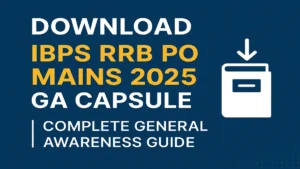
TOPIC: Miscellaneous
Directions (1-10): Read the following passage carefully and answer the questions given below it. Certain words have been printed in bold to help you locate them while answering some of the questions.
Giving loans to impoverished women to make ceramics or to farmers to buy milk cows were not seen as great business. Microfinance was an industry championed by antipoverty activists. Today it is on the verge of a revolution, with billions of dollars from big banks, private – equity shops and pension funds pouring in, driving growth of 30% to 40% this year alone. In 1998, a non-profit microfinance organisation in Peru, converted into bank (called Mibanco). This demonstrated that the poor are good risks who repay loans on time and getting them together, not only chips away at poverty but also turns a profit. The success of Mibanco has piqued the interest of commercial banks, which had previously shunned the country’s poor. Now big banks are going after Mibanco’s clients with low-rate loans and realising it takes special know – how to work with the unbanked – are hiring away Mibanco’s staff.
But with the emergence of players who are only out for profit, microfinance schemes could end up milking the poor. This could happen in countries where lenders don’t have to disclose interest rates. When a Mexican microfinancier went public, revealing its loans had rates of about 86% annually, the Consultative Group to Assist the Poor (CGAP) criticised it for putting shareholders ahead of clients. The pressure of turn a profit also forces microfinanciers to change their business models in ways that depart from the industry’s core mission : to help poor people lead better lives. Such shifts have caused the average loan size to triple. Moreover smaller loans being costlier to service, a lower percentage of loans go to women because they tend to take out smaller sums. According to CGAP, with the flood of new large entities there is the risk that a large percentage of cross-border funds go to Latin America and eastern Europe, the world’s most developed microfinance markets. “The poorest of the world’s poor, who are predominantly in Asia and Africa get left out,” says the CEO of the nonprofit Grameen Foundation, which helps develop microfinance institutions.
Segmenting the industry, might be worthwhile if it allows more of the poor to get access to credit. Multinational corporations could take the top micro-finance institutions to the next level, and the remainder could be the responsibility of development groups and regional banks. Yet making loans to poor people is hardly a poverty cure. Property rights and the rule of law matter too. One cannot overidealize what microfinance alone can do. Most nonprofits started with lending simply because local laws prohibited nonbanks from offering deposit accounts. With an increase in competition and marketing efforts, poverty – alleviation experts are concerned that people will be talked into loans they wouldn’t otherwise want, For example, organisations like Mibanco are providing consumer loans. There is nothing wrong with buying TVs and microwaves on credit, but certain markets, like Mexico, have been flooded with loans that have nothing to do with providing capital to aspiring entrepreneurs -just increasing household debt.
Q1. What does the transformation of Peru’s non-profit organisation into bank illustrate?
(A) To compete with commercial banks, microfinance institutions should convert into banks and offer a wide variety of services.
(B) Microfinance institutions turn higher profits as banks since interest rates on loans are at their discretion.
(C) The poor prefer to go to large banks rather than NGOs to obtain loans.
(a) None
(b) Both (A) and (B)
(c) All (A), (B) and (C)
(d) Only A
(e) None of these
Q2. Why did most microfinance institutions initially provide only credit services?
(a) They were unable to compete with the interest rates offered on deposits by commercial banks.
(b) They have to operate purely on a non-profit basis.
(c) Government restrictions prevented them from offering additional services.
(d) To ensure the poor have access to modem necessities like microwaves.
(e) None of these
Q3. What was the impact of the non disclosure of their interest rates by lending institutions ?
(a) The government issued sanctions against such firms.
(b) Shareholder`s interests were not protected
(c) More microfinance institutions were motivated to go public.
(d) The poor were exploited
(e) None of these
Q4. What is CGAP’s fear with respect to new entities providing microfinance?
(a) NGO will be unable to survive in an environment of cut throat competition
(b) The poor will hesitate to take advantage of credit facilities because of the formalities involved.
(c) The poor in the developed world will be overlooked
(d) The interests of the most deserving among the poor will be neglected.
(e) Shareholders interest will be ignored
Q5. Which of the following is/are challenge/s faced by Mibanco at present from big banks?
(A) Ensuring loyalty of their customers.
(B) Retention of employees
(C) Maintaining low interest rates.
(a) Only (C)
(b) Both (A) and (B)
(c) Both (B) and (C)
(d) Only B
(e) None of these
Q6. Which of the following is/are consequence/s of microfinanciers altering their business models ?
(A) Larger loan amounts get sanctioned.
(B) Debt among the poor has fallen in some countries.
(C) Drop in the loans awarded to women.
(a) Both (A) and (B)
(b) Both (A) and (C)
(c) Only (C)
(d) All (A), (B) and (C)
(e) None of these
Directions (7-8): Choose the word which is most similar in meaning to the word printed in bold as used in the passage.
Q7. Piqued
(a) provoked
(b) irritated
(c) disturb
(d) offended
(e) fascinated
Q8. Verge
(a) tend
(b) crossroad
(c) ascent
(d) slope
(e) threshold
Directions (9-10): Choose the word which is most OPPOSITE in meaning to the word printed in bold as used in the passage.
Q9. Aspiring
(a) uninterested
(b) ungrateful
(c) anxious
(d) miserable
(e) fraudulent
Q10. Core
(a) clear
(b) unnecessary
(c) crust
(d) beside
(e) uncoordinated
Directions (11-15): Rearrange the following seven sentences (A), (B), (C), (D), (E), (F) and (G) in the proper sequence to form a meaningful paragraph; then answer the questions given below them.
(A) But seriously, how much would you pay to know what thoughts are swimming around in someone else’s head?
(B) In most fictional movies thus, the idea of reading minds-of seeing the private intentions of another, and the possibility of intervening in those plans – has always been highly attractive
(C) such fantastical questions have long been the bread and butter of fiction.
(D) Today, more than four centuries since the phrase, “A penny for your thoughts?”, was first recorded, inflationary accounting makes that ancient penny worth more than $40.
(E) The going rate for a “thought”– a probe into the thinking of another –was once quite a bargain.
(F) And if you could really know their truthfulness how much more would you pay?
(G) Even with the sliding value of dollar, this still seems quite a bargain.
Q11. Which of the following should be the SECOND sentence after rearrangement?
(a) F
(b) D
(c) C
(d) G
(e) A
Q12. Which of the following should be the FOURTH sentence after rearrangement?
(a) A
(b) B
(c) G
(d) D
(e) F
Q13. Which of the following should be the SIXTH sentence after rearrangement?
(a) E
(b) G
(c) C
(d) B
(e) A
Q14. Which of the following should be the SEVENTH (Last) sentence after rearrangement?
(a) A
(b) B
(c) F
(d) D
(e) E
Q15. Which of the following should be the FIRST sentence after rearrangement?
(a) A
(b) B
(c) C
(d) D
(e) E
SOLJUTIONS:
S1. Ans. (d)
Sol. To compete with commercial banks, microfinance institutions should convert into banks and offer a wide variety of services.
S2. Ans. (b)
Sol. They have to operate purely on a non-profit basis.
S3. Ans. (d)
Sol. But with the emergence of players who are only out for profit, microfinance schemes could end up milking the poor.
S4. Ans. (d)
Sol. The interests of the most deserving among the poor will be neglected.
S5. Ans. (a)
Sol. Refer to first paragraph of the passage. “This demonstrated that the poor are good risks who repay loans on time and getting them together, not only chips away at poverty but also turns a profit.”
S6. Ans. (c)
Sol. Refer to second paragraph of the passage. “Moreover smaller loans being costlier to service, a lower percentage of loans go to women because they tend to take out smaller sums.”
S7. Ans. (e)
Sol. Pique means to make somebody very interested in something. So, fascinated is the word which is similar in meaning to it.
S8. Ans. (e)
Sol. Verge means very near to the moment when somebody does something or something happens. So, threshold is the word which is similar in meaning to it.
S9. Ans. (a)
Sol. Aspiring means wanting to start the career or activity that is mentioned. So, Uninterested is the word which is opposite in meaning to it.
S10. Ans. (b)
Sol. Core means the most important or central part of something. So, Unnecessary is the word which is opposite in meaning to it.
S11. Ans. (b)
Sol. The correct sequence to form meaningful sequence is EDGAFCB.
S12. Ans. (a)
Sol. The correct sequence to form meaningful sequence is EDGAFCB.
S13. Ans. (c)
Sol. The correct sequence to form meaningful sequence is EDGAFCB.
S14. Ans. (b)
Sol. The correct sequence to form meaningful sequence is EDGAFCB.
S15. Ans. (e)
Sol. The correct sequence to form meaningful sequence is EDGAFCB.


 IBPS RRB PO Mains 2025 GA कैप्सूल डाउनलो...
IBPS RRB PO Mains 2025 GA कैप्सूल डाउनलो...
 SBI की बड़ी घोषणा! हर साल होगी 16,000 नई...
SBI की बड़ी घोषणा! हर साल होगी 16,000 नई...
 IBPS RRB Clerk Pre 2025 Memory Based Pap...
IBPS RRB Clerk Pre 2025 Memory Based Pap...








